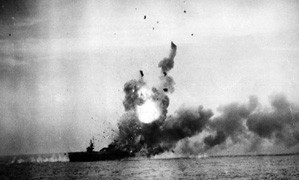
Kamikaze
The crew of the escort carrier St. Lo (CVE 63) thought that they had lived through the worst they would see during the early morning of October 25, 1944. Their mission normally consisted of launching aircraft for close air support missions against enemy islands or conducting antisubmarine patrols. Yet, on that day they joined other escort carriers of their task group in combating a powerful Japanese surface force in the waters off Samar in the Philippines. The lightly armored carriers, their planes, and their escort ships turned the enemy back with a heroic defense. While one escort carrier, Gambier Bay (CVE 73), was sunk by enemy fire, St. Lo emerged from the action relatively unscathed . All of that changed at 1050 hours when the drone of aircraft engines signaled an enemy air attack. Yet, this would be an attack like none witnessed before by any American sailor, the familiar silhouettes of Japanese aircraft with the red meatball insignias in their wings diving directly at the ship, the pilots not seeking to release ordnance, but instead deliberately crash their planes.
At 1051 hours one of the aircraft smashed into the St. Lo‘s flight deck, exploding below decks in the worst possible spot, the magazine in which the escort carrier’s torpedoes and bombs were stored. Within moments the ship was engulfed in flames and in just half an hour, as an official Navy history of the ship recounted, she “sank…leaving a cloud of dense black smoke to mark her watery grave.” Over the course of ensuing months, many more Allied sailors would bear witness to what those on St. Lo experienced that morning, feeling the deadly breath of the divine wind as Japanese kamikazes, suicide aircraft, waged a desperate battle to protect their homeland. It was an effort ultimately doomed to fail, but one that exacted a horrible price in lives and ships sunk or heavily damaged.
Displayed here are items in the collection of the National Naval Aviation Museum relating to kamikaze attacks during World War II.


